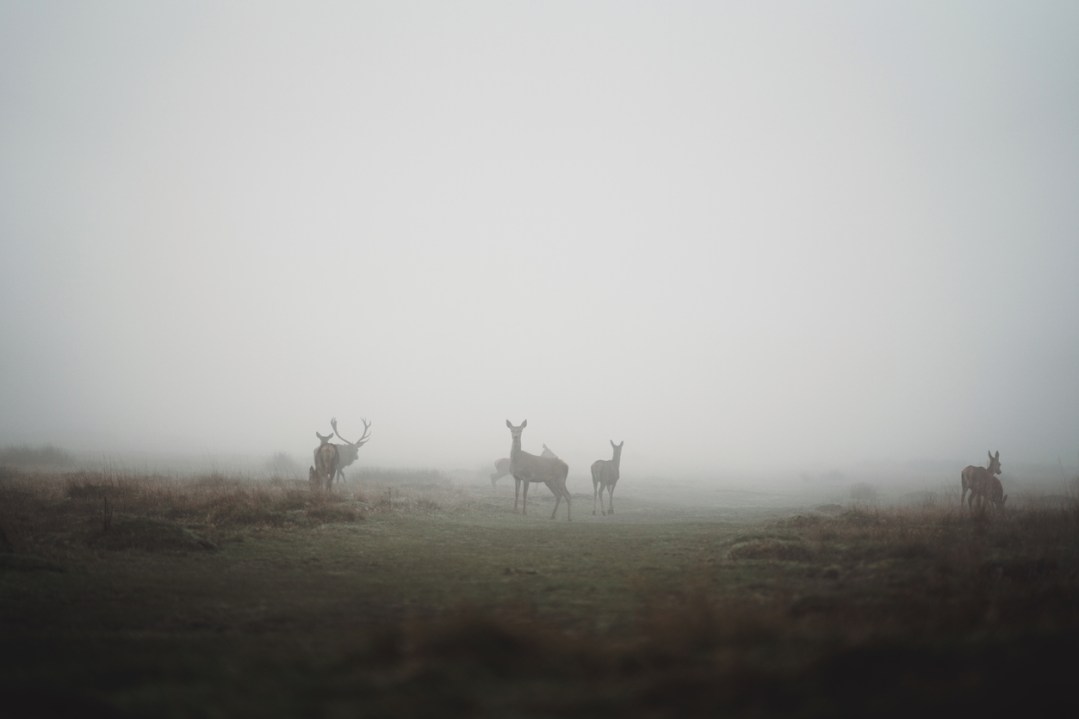It was standing completely still, about 40 yards away, partially obscured by a clump of hazel: a pure white deer. It looked almost iridescent in the gloom of an overcast winter day. My dogs were straining at the lead but otherwise all sense of movement ceased for half a minute, maybe longer.
I managed to decapitate it with a twist and fastened the head and horns to my car roof with bungee cords
Then something broke. The white deer twitched. It was only when it began to run that we realised it had been accompanied by half a dozen other, darker-skinned herdmates. In just a few seconds we were alone again. The straining dogs were the only sign that anything had happened at all.
I had met an old friend in Blackboys, east Sussex, early on a Sunday morning a couple of weeks ago and we were the first out walking. It was my friend who first spotted it. He’s always had better eyes for this sort of thing, going back to our days fishing at school. I’ve seen a white deer once before. The last time, 21 years ago, was also early on a Sunday morning, a few miles further north, in a clearing in Hargate Forest, on the Kent side of the Sussex border near Tunbridge Wells. On that occasion the deer was a stag with antlers, a white hart, and was part of a herd some 40-odd strong which emerged out of low mist.
I’ve often thought about that moment since and wondered if I’d ever encounter a white deer again. Two decades on, I have. This time the deer was, I think, a female fallow. If it had had red eyes (it was impossible to tell at that distance) it would have been an albino but the more common cause is leucism, an absence of pigment, so it was almost certainly this that we saw.
There are as many as two million deer in Britain, a record high; it’s now not uncommon to see them in our suburbs, thanks to an abundance of food and a lack of natural predators – and a decline in human ones, too. In the last couple of years I’ve seen muntjac in our local park in north London and a group of roe deer in the woods by the A4 near Heathrow. A family friend recently wrote off his car hitting a deer on the A26, a couple of miles up the road from where I saw my white hart.
Deer are among the earliest elements of European culture; there are ancient tools made of antler and they appear in cave painting across the continent. The 15,000-year-old image known as ‘The Sorcerer’ in caves in Ariège in south west France, shows a human figure with the horns of a stag. Pre-Roman cultures repeatedly depict similar horned man-beasts, including the Greeks’ Pan and the Celts’ Cernunnos.
As Christianity spread northwards from Rome, such pagan figures were subsumed into the new religion. Peter Stanford in The Devil: A Biography describes how the folklore image of the horned man became a template for depicting Satan, continued today in the red devil horns which are a staple of Halloween costumes. Sinister horned figures appear in British folk horror films like The White Reindeer, Blood on Satan’s Claw and The Wicker Man.
I spotted a decomposing stag on a slip road off the M23 in Sussex a couple of years ago. I managed to decapitate it with a twist and fastened the head and horns to my car roof with bungee cords. A boil and a bleach later and the antlers were on the walls of our front room. Then last summer, on Arran, I found the remains of a proper monarch-of-the-glen, a huge red stag that had died in a remote gully. This provided an even more spectacular set of antlers which is now mounted on our back garden fence. It’s too big for any room in the house.
All deer have some folkloric resonance but white ones are, of course, much rarer. They are symbol of purity, a sign of imminent change, a messenger from underworld and a portent of death – though I’m rather hoping this doesn’t apply to my recent sighting.
This article is free to read
To unlock more articles, subscribe to get 3 months of unlimited access for just $5








Comments
Join the debate for just £1 a month
Be part of the conversation with other Spectator readers by getting your first three months for £3.
UNLOCK ACCESS Just £1 a monthAlready a subscriber? Log in